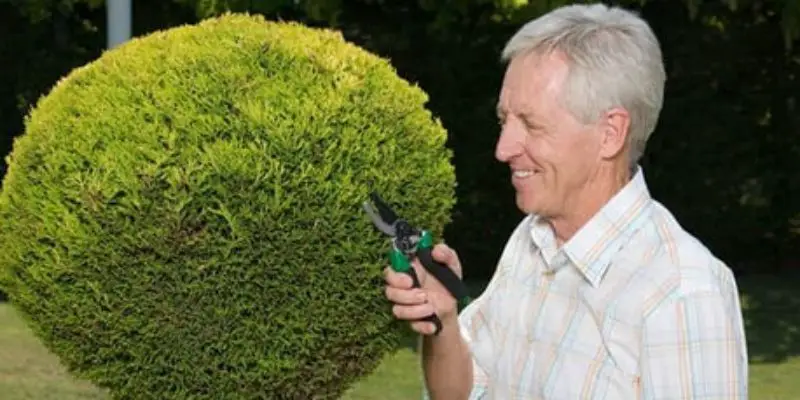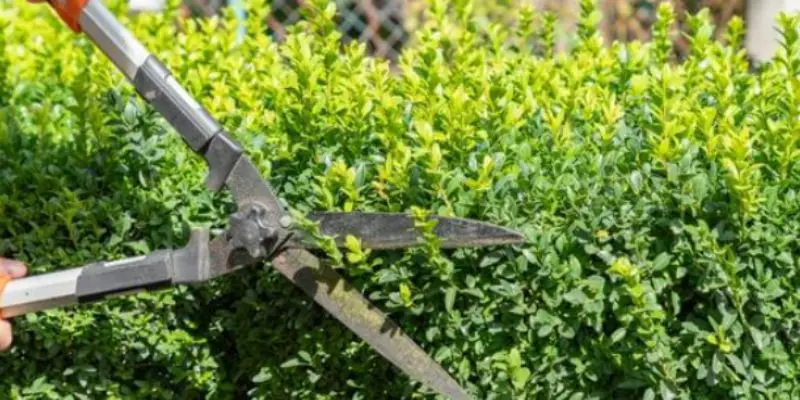Cypress trees are a popular choice for landscaping due to their graceful, arching branches and lovely green foliage. However, keeping your cypress trees neatly trimmed is important not only for aesthetics but for the health of the tree as well. Learning how to properly trim a cypress tree may seem daunting, but it’s easier than you think with the right tools and techniques.
In this comprehensive guide, we’ll cover everything you need to know about how to trim cypress trees. You’ll learn about the ideal time to trim cypress trees, what tools work best, specifics on shaping and structural pruning methods, as well as vital aftercare to promote growth. We’ll also provide tips to make trimming cypress trees an easier, safer task.
When to Trim Cypress Trees
The first decision in learning how to trim cypress trees is timing. Cypress trees grow rapidly, some species adding over three feet in height per year. This quick growth means they require frequent trimming to keep their shape.
Cypress trees should be trimmed in late winter or early spring before new growth emerges. Late winter pruning encourages the tree to produce lots of lush new growth once warmer weather arrives. Trimming cypress trees during dormancy also minimizes sap bleeding from cuts that can attract insects.
Early spring is another ideal time for trimming cypress trees while they are still dormant. However, you run more of a risk of damaging tender new growth if spring pruning is delayed too long. Take care not to accidentally snip off the light green new shoots which typically grow at branch tips.
Tools and Supplies for Trimming Cypress Trees
Learning the proper techniques for how to trim cypress trees is useless without having the right tools for the job. Trimming cypress trees requires some specialized equipment to reach upper branches safely.
Here is a list of the must-have tools and supplies for DIY cypress tree trimming:
• Hand pruners: Hand pruners with curved blades work well for smaller branches up to half an inch diameter. Look for quality bypass pruners versus anvil pruners.
• Loppers: Loppers offer greater cutting capacity than pruners, chopping through branches around 1.5 inches thick.
• Pole pruners: Pole pruners help prune beyond arm’s reach. A telescoping handle offers safe trimming at heights up to 12 feet or more.
• Chainsaw: For large branches, a chainsaw safely cuts through thicker limbs a pruner cannot handle.
• Tree trimming saw: A curved hand saw helps remove whole branches where they attach to parent stems.
• Safety equipment: This includes goggles, sturdy gloves, ear protection, hard hat, and boots with grip.
• Tree trimmer: Professional arborists use specialized vehicles with an enclosed platform called a tree trimmer to safely access high branches. Renting a tree trimmer is ideal for tall cypress trees or for inexperienced trimmers.
Now that you know which tools work best for the job, let’s review proper technique for how to trim cypress trees.
Also read: 7 Best Top Rated Electric Hedge Trimmers – A Detailed Buying Guide
Structural Pruning of Cypress Trees

The term structural pruning refers to selectively removing entire branches to shape cypress trees or improve their architecture. Careful structural pruning when young helps cypress trees develop a strong central trunk and open canopy shape.
Here are some structural pruning tips for nicely shaped cypress trees:
1. Identify a single main leader:
Choose one central vertical stem to preserve as the leader. Remove competing shoots that may develop multiple leaders over time.
2. Eliminate inward growing branches:
Branches that cross through the canopy shade lower branches and encourage interior foliage dieback. Always prune out narrow crotch angle limbs.
3. Retain outward growing lateral branches:
Wide angle horizontal branches with full exposure to sunlight help form an attractive conical or pyramidal silhouette.
4. Space branches evenly:
Try to space lateral scaffold branches at least 6 inches apart vertically to allow light and air flow.
5. Remove lower branches gradually:
As the cypress tree matures, systematically remove lower branches over time. Retain some lower foliage on young cypress trees to protect their trunks.
When structurally pruning branches, always cut just outside the branch collar. The branch collar is a cushion of overlapping bark tissue where a branch attaches to a parent limb or the main trunk. Cutting too close risks damaging protective bark layers. Damaging the branch collar enables insects and disease to invade the stem tissue.
Also use proper technique when pruning cypress trees to avoid tearing of bark tissue. When removing whole branches, always use three cuts to prevent tearing of the bark. This helps keep the branch collar intact for faster wound closure.
First make an undercut a few inches away from the stem several inches up from the bottom of the branch. Next make a top cut directly above leaving a few inches of the branch stump. Then cut the remaining branch stub just outside the branch collar.
Identifying Common Cypress Tree Varieties and Their Pruning Needs
When it comes to caring for cypress trees properly, step one is getting to know the different types you have. These evergreen beauties come in all shapes and sizes, and each variety needs pruning a little differently.
Let’s take the tall, slender Italian cypress – you know, those that can reach 60 feet tall. They have that striking column look when lining a driveway or framing an entry. To keep them in tip-top shape, carefully trim back branches going rogue, but don’t overdo it. Cut off too much at once and you’ll stress the poor tree.
Then there are the fast-growing Leyland cypresses with their dense, pyramid-like shape. They can skyrocket over 50 feet tall, which is why folks use them for privacy screens or wind breaks. When pruning Leylands, feel free to make more liberal cuts – just snip off stray or uneven branches to maintain that compact form. But steer clear of heavy-handed trimming which can leave unsightly bare patches.
And down southwest, the drought-tolerant Arizona cypress is a real standout with its silvery blue foliage and natural pyramid shape. When trimming, focus on reinforcing that tapered look by carefully cutting back any branches getting too long or out of proportion. Just don’t remove more than a third of the foliage at once, or you risk unbalancing the whole tree.
Unique Growth Habits and Pruning Considerations for Each Variety
No matter the cypress type, the basic pruning principles are similar. First, take a close look at its shape and structure to spot trimming needs. Then use clean pruners or a hand saw to gently remove dead, damaged or diseased branches, cutting back to the nearest healthy spot.
Next, thin out the interior by snipping branches growing too close together or inward, which opens up airflow and light. Make cuts just above healthy buds or connections at an angle to prevent water buildup.
And as you prune, keep an eye on preserving the natural silhouette – with tall Italian cypresses, narrow vertical cuts, and with pyramidal Leylands and Arizonas, a gentle taper.
Shaping and Thinning Cuts for Cypress Trees
In addition to structural pruning, regular thinning and shaping cuts are equally important for cypress tree health. While structural pruning focuses on branch placement, thinning helps regulate foliage density.
Here are some key points about thinning cypress trees properly:
1. Remove inner foliage first:
Prioritize removing leaves and small branches in the interior canopy exposed to less sunlight.
2. Thin areas of dense growth:
Regions with overly congested leaves or branches should be selectively thinned to improve airflow.
3. Retain an even distribution:
Strive for evenly distributed foliage rather than removing too much from one section which looks unbalanced.
4. Avoid topping:
Never remove branch tips or shear off top growth as this damages the natural form.
Shaping cuts remove excess length from branches straying beyond the desired canopy perimeter. Take care only to prune back to just above another small lateral shoot. Removing entire branches risks survival of the important lateral branch structure.
Try to trim wayward branches little by little each season rather than drastic cutting. Never remove more than one-quarter of the tree’s total branches when pruning cypress trees. Removing too much green foliage at once stresses the tree.
Aftercare Tips for Pruned Cypress Trees

Learning how to properly trim a cypress tree also requires appropriate aftercare once pruning is complete. Follow these tips to help pruned cypress trees recover quickly:
• Clean tools thoroughly after each cut using diluted bleach avoiding spreading disease between trees.
• Apply horticultural wax or tree sealant to any cut over 1 inch across to deter insect invasion.
• Water cypress trees thoroughly after pruning to prevent additional stress. Continue deep watering every week during the growing season.
• Place protective tree wraps around thin bark prone to sun scald especially on younger transplanted cypress trees.
• Fertilize pruned cypress trees in early spring with a balanced 10-10-10 analysis fertilizer to encourage regrowth.
• Monitor for signs of disease and insects drawn to fresh wounds which may require prompt treatment.
• Delay any additional pruning for at least one full year to allow the cypress tree time to fully recover.
Safety Tips for Trimming Cypress Trees
Learning how to properly trim cypress trees also requires prioritizing safety. Here are some key safety reminders when tackling DIY cypress tree pruning:
• Keep both feet firmly planted on the ladder at all times when using hand tools overhead. Consider boom-type pole pruners for a safer reach.
• Use extreme caution when operating a chainsaw off the ground. Chainsaws should only be used while standing on an approved wooden ladder equipped with insulation.
• Always brace elbows firmly against your torso when cutting branches to prevent slipping and losing control of sharp pruning tools.
• Wear protective eye goggles, sturdy gloves, and hearing protection when using power tools like chainsaws. Stubborn cypress branches put up a fight when cut.
• Carefully assess which branches are safe for you to prune yourself versus calling a professional arborist to access dangerous high reaches near power lines or rooftops.
By keeping these important safety considerations in mind, pruning cypress trees poses less risk of accident or injury.
Best Electric Black & Decker Hedge Trimmer – Top 3 Corded Picks
Diagnosing and Addressing Common Cypress Tree Health Issues
The best way to enjoy those gorgeous evergreen cypress trees is to keep them in good shape. They may look tough, but cypress can struggle with some pests, diseases and environment problems. Let me give you a rundown of the common issues and how to tackle them as you continue learning how to trim cypress trees.
Identifying and Treating Common Pests
All kinds of little critters like to munch on cypress. One pest you often see is the cypress aphid. They suck the sap and can stunt growth or even make needles drop early. To get rid of them, use insecticidal soap or horticultural oil. Those smother the aphids without hurting the tree.
Another bug is the cypress bark beetle. They burrow in and disrupt nutrients and water flow, which wilts and kills branches or even the whole tree. If you spot infested areas, prune them off right away. If it’s really bad, you may need insecticide too.
Fungal Diseases and Their Treatment
Fungus can also cause trouble. Cypress canker shows up as sunken, discolored spots that can severely damage the trunk and branches if untreated. Prune off affected parts and use fungicide to stop the spread.
Twig blight makes branch tips wilt and die back. Snip off those pieces and protect the healthy areas with fungicide.
Environmental Stressors and Mitigation Strategies
Environmental things like drought, too much water, or compacted soil place stress on cypress too. During dry spells, make sure they have enough H2O. Overwatering can cause root rot as well. Loosen up packed dirt and add organic matter so roots can thrive.
Proactive Measures to Maintain Cypress Tree Vigor and Resilience
The best defense is a good offense. Plant cypress where the soil drains well and there’s sunlight. Trim branches regularly for air flow and shape. And feed them sometimes with balanced fertilizer to keep problems at bay. With a little TLC, your cypress trees will stay happy for years!
Cypress Tree Transplanting and Relocation Guidelines
As you learn how to trim cypress trees, it’ll also help to know how to transplant cypress trees. Though transplanting a fully grown cypress tree may be challenging, when handled appropriately, it is possible. Properly knowing the right time and way to move them can be helpful in ensuring that they survive and keep growing. Let us now get into more details on how to handle transplanting and relocating cypress trees.
Proper Timing and Methods for Safely Moving Established Cypress Trees
The timing of removal of a cypress tree is important. Cypress trees should be moved at the dormant period of the year with no growth, which is usually in late autumn or early winter. This will minimize plant stress and increase chances of successful transplantation.
Nonetheless, moving itself must be done cautiously. Firstly, ascertain an appropriate rootball size – ideally it should have a diameter around 10-12 times bigger than that of the tree’s trunk so that enough roots are contained in it to support the tree.
While digging around this rootball, cover it with burlap or any other protective material so that its roots do not dry out while being transported. Additionally, prune any big unruly roots that may be obstructive as well. This ensures that the rootball remains compacted and making it easier for transportation.
A skid steer or small tractor with a tree spade attachment will do great job in lifting and moving the tree. Lift up the rootball with care while securing it till when you reach new planting site. Go slowly and avoid any sudden movements that could damage the roots.
7 Best Top Rated Electric Hedge Trimmers – A Detailed Buying Guide
Aftercare and Monitoring for Transplanted Cypress Trees
The real work begins after you have safely planted your cypress tree in its new location. Proper aftercare is essential to give the tree the best chance of becoming established and thriving in its new home.
Firstly, ensure that your tree is getting enough water. Frequently water newly-transplanted cypress trees, especially during their first growing season. The soil should be moist but not waterlogged at all times.
Additionally, a lot of mulch should be provided around the base of the tree extending out to cover over drip line. This will help hold moisture within it as well as control weeds, which compete with cypress trees for sunlight, nutrients, water, space etc. However, ensure that you keep away mulch from trunk by few inches in order to prevent rotting process.
It is mandatory to frequently check for stress signs and pest/disease issues. Be on the lookout for desiccation, leaves that are discoloured or dying back then deal with any problems that arise immediately. When in doubt about the condition of your tree, engage an arborist from the area.
Guidelines for Planting and Establishing Cypress Trees
Sometimes it is more logical to plant a brand new cypress tree than trying to relocate an established one. There are some things you need to bear in mind when it comes to planting and establishment of these trees.
Selection of Optimal Site, Preparation of Soil, Planting Practices
If there is anything important related to cypress trees, it is selecting appropriate sites for planting them. They flourish well in well-drained slightly acidic soil and require full sun exposure. Steer clear of heavy or compacted soils as well as poorly drained areas that can result into root rot among other complications.
Take time to adequately prepare soil before commencing with planting exercise; loosen the ground up to depth of approximately 12 inches and mix some organic matters such as compost or aged barks. This will ensure that their roots have enough spaces where they can spread out and find nutrients.
Dig a hole that is 2-3 times the width of the root ball but not any deeper when it is time to plant. Make sure the top of the root ball is level with the surrounding soil, when planting tree in hole. Fill around with original soil and tamp gently to remove air pockets.
Lastly, add a thick layer of mulch around the base of your tree ensuring you do not lay it against the trunk. This will help maintain moisture and control weeds form spreading.
Caring for Newly Planted Cypress Trees during Establishment
It is important that you take care of a newly planted cypress tree during establishment period. The first year or two will be spent by the tree mostly growing its roots deep into the ground so close attention should be made on watering as well as nutrition for its survival.
Watering, regular and penetrating one, must be done consistently. Aim at having moist soil all time though without water setting in it like slushy mud. Keep a watchful eye on your tree and adjust watering schedules accordingly depending on weather situations and how well your tree responds in kind.
Also, periodic fertilization can assist in promoting vigorous growth when they are still establishing. Seek out a balanced, slow-release fertilizer designed for use on trees and apply it as directed by the manufacturer. Do not over-fertilize as this may have some consequences.
The pruning process may also be required to make sure the tree grows well and eliminate damaged branches or those that compete with others. Nevertheless, too much cutting back during the first few years could cause stress to the tree. Instead, light selective pruning should be applied so that the desire of the form is maintained.
Aesthetics and Design Applications of Cypress Trees
Once you learn how to trim cypress trees, you will be a step closer towards applying them for aesthetic purposes. Cypress trees are highly valued for their bold architectural forms and versatility in landscaping. They can be used in many different ways whether you prefer a manicured formal look or a wilder more naturalistic approach.
Incorporating Cypress Trees into Various Landscape Styles and Themes
One of the best things about cypress trees is that they can be modified to suit any type of landscape style. When placed in rows or groups, they will create a formal traditional setting due to their tall columnar shapes and dense foliage which results in stately elegance; this is especially good for framing entryways, pathways or focal areas.
Cypress trees are beautiful accent plants or anchors for a less formal landscape, if you prefer a more realistic, woodland-inspired look. Let their limbs spread out more and allow the other native plants and ground covers to develop a peaceful organic tone around them.
Even modern minimalist designs can be made with cypress trees. These architectural forms are particularly interesting when used as single sculptures or simple geometric plantings.
How to Trim Cypress Trees to Produce Intended Visual Effects and Forms
Pruning is one of the essential operations that should be done by all gardeners who want the cypresses to remain in good shape as they want them to appear. Many different pruning methods produce great visual effects and forms.
For an official appearance that is traditional in nature, regular and precise pruning keeps it columnar-shaped tightly. To make the hedge seem well-trimmed, you need to trim its sides as well as top edges.
Alternatively, you could use selective pruning that will result into removing just competing branches growing at wrong direction thereby causing unnatural growth pattern for free formation so that it develops into pyramidal silhouette naturally with little interruption.
On the other hand, dramatic pruning techniques such as pollarding and espalier can be employed if your aim is to create artistic sculpture-like effects. These involve carefully cutting off main branches to promote the development of unique, visually striking forms.
Final Thoughts on How to Trim Cypress Trees
Learning proper techniques makes pruning cypress trees a less intimidating task. Following the guidelines above for correct tools, timing, branch selection, and aftercare keeps cypress trees healthy and looking their best.
Remember to prune cypress trees during winter dormancy before new growth emerges in spring when sap flow is minimized. Always sterilize pruning equipment after each cut to reduce disease transmission when removing diseased wood. Take time to thin inner branches for ideal sunlight penetration and airflow as well.
With the right approach, learning how to trim cypress trees can be simple. Keeping them neatly manicured improves the tree’s resilience against insects, disease, wind, and ice damage. Your well-shaped cypress trees will thank you for your careful handiwork with lush new growth year after year.
Trim your cypress trees into shape each dormant season before impressive new foliage unfurls along every branch.
Also read:
Best Electric Hedge Shears – Top 6 Reviews and Buying Guide
Best Electric Bush Trimmers – Top 5 Reviews and Buying Guide

Michael Glenn is a certified arborist and horticultural expert with over 15 years of experience in the landscape industry. His passion for plants and trees has led him to become a sought-after authority on pruning and trimming techniques. Glenn’s in-depth knowledge of proper pruning methods, timing, and tools has helped countless homeowners and professionals maintain healthy, aesthetically pleasing gardens and landscapes.
In addition to sharing his pruning expertise through practical tips, step-by-step guides, and expert advice, Glenn is also a respected author of pruning tool buying guides. His comprehensive reviews and comparisons ensure readers can make informed decisions when investing in quality loppers, pruning shears, saws, and other essential equipment. With a deep understanding of plant biology and sustainable practices, Glenn’s writing empowers audiences with the knowledge needed to properly care for green spaces.





